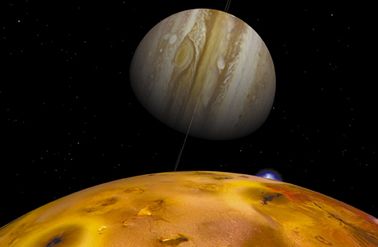
 |
|
This image shows a realistic view of what it would look like to be orbiting near Jupiter's moon Io as Jupiter comes into view displaying its Great Red Spot. The extraordinarily dark rings discovered in the Voyager missions are exaggerated to make them visible. This computer visualization was created using data from both NASA's Voyager and Galileo missions. (From the Voyage scale model solar system, developed by Challenger Center for Space Science Education, the Smithsonian Institution, and NASA. Image created by ARC Science Simulations © 2001.) |
The model Jupiter is the size of a marble, making it a giant in comparison to the planets of the inner solar system. Indeed, Jupiter is so different from the planets of the inner solar system that we must create an entirely new mental image of the term planet. Its mass is more than 300 times that of the Earth, and its volume is more than 1,000 times that of the Earth. Its most famous feature--a long-lived storm called the Great Red Spot--is itself large enough to swallow two or three Earths. Like the Sun, Jupiter is made primarily of hydrogen and helium and has no solid surface. If you plunged deep into Jupiter, you would be crushed by the increasing gas pressure long before you ever reached its core.
Jupiter reigns over at least 28 moons and a thin set of rings (too faint to be seen in most photographs). The four largest moons--Io, Europa, Ganymede, and Callisto (often called the Galilean moons because they were discovered by Galileo)--are fascinating worlds in their own right and are easily visible on the scale of the model solar system. Io is the most volcanically active place in the solar system. Europa's icy crust probably hides a subsurface ocean of liquid water, making Europa a promising place to search for life. Indeed, as we'll discuss in Chapter 11, the moons of Jupiter and the other outer planets are at least as interesting as the planets themselves.
 |
|
This map shows Jupiter's location in the Voyage scale model solar system on the National Mall in Washington, DC. The image at the top of the page (next to title) shows Jupiter's size on the scale. |